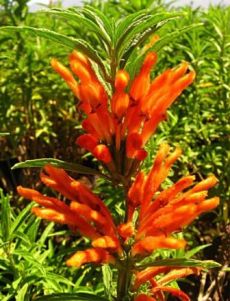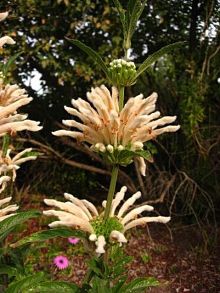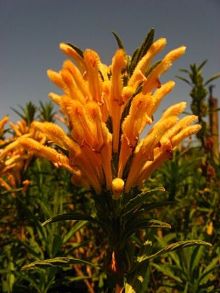 Leonotis leonurus Condensed Version:
Leonotis leonurus Condensed Version:
Seven species of Leonotis occur in southern Africa, with Leonotis leonurus being the most well-known and commonly cultivated. This outstanding indigenous plant has become an extremely popular garden subject because of its brilliant orange flowers, fast growth, and adaptability to a wide range of climatic conditions throughout the country. White, light orange and peachy orange forms are also available.
Wild dagga does not have aggressive roots and is perfect for gardens small and large. Try planting it in groups at the back of the mixed shrub border, interspersed with the white flowered forms to create a brilliant contrast. It is essential in all indigenous wildlife gardens; and a beautiful addition to grassland and fynbos gardens, combining perfectly with aloes, succulents, proteas, pincushions and Leucadendrons. The flowers will attract bees, butterflies and moths to your garden and secrete a plentiful supply of nectar for sunbirds.
The lion’s ear is suitable for growing in a wide range of climatic conditions throughout South Africa. It loves full sun, and will grow in any fertile, well-drained garden soil. Although this plant is drought tolerant, it will perform best in the garden if it is watered regularly until established and moderately thereafter. Regular feeding with a balanced fertiliser like 3:1:5 during summer will ensure a splendid floral display later. It flourishes in the subtropical summer rainfall regions, and also grows well in the winter rainfall regions. It also thrives in the Highveld regions and tolerates moderate frost if it can be protected from freezing winter winds. In the dry continental regions it requires regular watering during long dry summer spells to look its best; and in these regions growth is also less vigorous.
Leonotis growing in the wild often dies back after flowering, with new growth appearing again in spring; but in warmer gardens where it is watered in winter it will remain evergreen. Prune the branches back to about three quarters in early spring, before the plant begins shooting new growth. This will encourage strong new shoots and prevents the branches from becoming top-heavy and falling over during heavy rains and strong winds. After several years, when the plants become woody and unattractive, it is best to replace them with new plants.
 Leonotis leonurus 'White Lion' Full Version:
Leonotis leonurus 'White Lion' Full Version:
Description, History & Interesting Facts:
Leonotis is a robust genus of slender shrubs with about 10 species, and endemic to sub-Saharan Africa. Endemic plants are native or restricted only to a certain country or area. Seven species of Leonotis occur in southern Africa, with Leonotis leonurus being the most well-known and commonly cultivated. This outstanding indigenous plant has become an extremely popular garden subject because of its brilliant orange flowers, fast growth, and adaptability to a wide range of climatic conditions throughout the country. White, light orange and peachy orange forms are also available. Although often referred to as “wild dagga” Leonotis is not related to true dagga (Cannabis sativa) which belongs to a different family and originated in Asia.
The name “leonotis” is derived from two Greek words and means “lion’s ear” - hence its common name, referring to the fringed or hairy upper lip of each velvety flower, which resembles a lion’s ear. Blooms are produced in abundant whorls along the stems in late summer, autumn, and even into winter, depending on localized growing conditions. The base of the flowers is filled with sweet nectar, attracting bees, moths, butterflies, birds and insects to the garden.
(Leonotis leonurus) with its brilliant orange flowers, produced in abundant whorls along the stems in late summer, autumn or winter, is the most widespread species throughout South Africa, occurring from the Olifants River Valley near Clanwilliam to Cape Agulhas in the southern Cape, eastwards along the coastline and inland to eastern Gauteng. It can be found growing in a variety of habitats including; sandy flats, on rocky hillsides, at forest margins, alongside river banks, and in grasslands. This multi-stemmed shrub can reach 2 to 3m tall and 1 to 1.5m wide and has long, slender, aromatic green leaves with toothed margins, and rough upper surfaces with velvety undersides.
(Leonotis leonurus leonurus ‘Golden Velvet’) is a wonderful golden orange form.
(Leonotis leonurus var. albiflora ‘White Lion’) is a beautiful creamy-white form which is rare in the wild and propagated from cuttings as it does not breed true to type from seed. It reaches the same height and spread as its orange cousins and performs equally well in the garden.
(Leonotis leonurus ‘Harrismith White’) is another extremely good white variety.
(Leonotis ocymifolia) is a species with a very wide distribution and can be found growing wild from Clanwilliam in the Western Cape to southern Sudan. It is common on rocky slopes where it grows in full sun to a height of about 2m. Its oval-shaped leaves are shorter and broader than those of L. leonurus and its orange flowers emerge from showy, spiky green balls. Once dried the seed pods make beautiful additions to dry flower arrangements, and, if sprayed, make great Christmas decorations. This species is not as long lived as L. leonurus and doesn’t respond as well to pruning, so needs replacing every three years or so, but is easy to propagate. It performs well on sharply drained soils and is extremely water wise once established, surviving on rainfall alone.
Uses:
The lions ear is widely used in African medicine to treat many ailments, from the common cold and coughs, to asthma, headaches, fever, high blood pressure, haemorrhoids, and dysentery, to name but a few. It is also used as a remedy for snake bite and as a charm to keep snakes away.
In the Garden:
Wild dagga does not have aggressive roots and is perfect for gardens small and large. Try planting it in groups at the back of the mixed shrub border for a bright splash of colour and dramatic vertical accent. The white flowered forms are excellent interspersed amongst the orange ones, and create a brilliant contrast when planted between clumps of autumn and early winter flowering Aloe arborescens, with its bright red flowers. Leonotis is essential in all indigenous wildlife gardens; and a beautiful addition to grassland gardens, combining perfectly with aloes and succulents. In fynbos gardens they blend beautifully with proteas, pincushions and Leucadendrons. The flowers will attract bees, butterflies and moths to your garden and secrete a plentiful supply of nectar for sunbirds, including the lesser double-collared, olive, black and malachite sunbirds. The flowers also attract insects, which in turn will attract insect eating birds.
The lion’s ear is an unusual and sought after cut flower which will last for several days if the stems are picked in the cool of the day. The leaves tend to droop, so remove them all, leaving only the flower whorls. The topmost flower bud on the stem also tends to wilt and is usually removed as well. Crush the woody stems and give them a long drink of water before arranging. The dried flower stems and seed heads can be sprayed or painted for Christmas decorations and abstract designs.
 Leonotis leonurus Golden Velvet newplantCultivation:
Leonotis leonurus Golden Velvet newplantCultivation:
The lion’s ear is suitable for growing in a wide range of climatic conditions throughout South Africa and does not have aggressive roots. It loves full sun, and will grow in any fertile, well-drained garden soil. Although this plant is drought tolerant, it will perform best in the garden if it is watered regularly until established and moderately thereafter. Regular feeding with a balanced fertiliser like 3:1:5 during summer will ensure a splendid floral display later.
Although it flourishes in the subtropical summer rainfall regions, it also grows well in the winter rainfall regions, but needs protection from strong winds to look its best, and requires a good layer of mulch around the roots in summer. It also thrives in the temperate, summer rainfall or Highveld regions and tolerates moderate frost if it can be protected from freezing winter winds. In these regions, established plants will require very little watering during the dry winter months. If it is extremely cold the plants will die down completely in winter, but if the roots are mulched, the plant should shoot again in spring. In the dry continental regions it requires regular watering during long dry summer spells to look its best; and in these regions growth is also less vigorous.
Leonotis growing in the wild often dies back after flowering, with new growth appearing again in spring; but in warmer gardens where it is watered in winter it will remain evergreen. Prune the branches back to about three quarters in early spring, before the plant begins shooting new growth. This will encourage strong new shoots and prevents the branches from becoming top-heavy and falling over during heavy rains and strong winds. After several years, when the plants become woody and unattractive, it is best to replace them with new plants.
Propagation:
Propagation is very easy by means of sowing seeds; division of the roots in spring; or by softwood or semi-hardwood cuttings, taken in spring and early summer.
Pests & Diseases:
This tough plant suffers from no serious pests or diseases. Watch out for whiteflies and spider mites, particularly on overwintering plants, and on plants grown in very secluded positions.
This plant is not poisonous.


